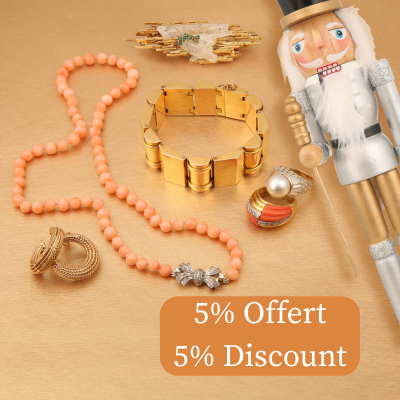The lucky jewels : Lucky charms, grigris, amulets and superstitions

Beliefs about lucky charms go back to antiquity and have been present in most cultures. Grigris can be linked to religious, spiritual or cultural beliefs but this type of jewelry sometimes comes from superstitions. Lucky charms, grigris or amulets are accessories that have crossed the centuries. From time immemorial, men have owned them and have had certain beliefs linked to them. The first lucky charms were centered on the sky and the stars, mystical presences filled with superstitious beliefs, which have always been associated with protection. From this came jewelry related to astrological signs.
Lucky charms are known to bring luck, protection, happiness and success to its owner. This type of jewelry is available in the form of necklaces, bracelets, rings, keychains and many others.
It is said that the magic of the grigri will only take effect if the person that is concerned believes in it strongly. It is all a matter of conviction. Great historical figures and celebrities were also superstitious and had grigris : Napoleon, Catherine de Medici, Louis XIV, Elizabeth Taylor or Michelle Yeoh. If we had to name only one famous personality from the world of fashion and jewelry who was very superstitious, we would have to talk about Christian Dior. Indeed, superstition has been an integral part of the DNA of his house since its creation. The day before his meeting with Marcel Boussac, a businessman who wanted Christian Dior to take over one of his brands, Monsieur Dior stumbled on a star-shaped grigri. He took it as a sign of destiny that told him he was on the right path and that this dreaded meeting could be a great opportunity. With the help of his fortune teller, he decided to refuse to take over the company Philippe et Gaston and inquired instead about opening his own fashion house. Marcel Boussac accepted and thus the house of Dior was born. Even today, superstition is present, especially in the collections designed by Victoire de Castellane: for example the collection rose des vents, declining the lucky charm of Mr. Dior in malachite, mother of pearl, turquoise, pink opal ...

Christian Dior, Picture Credit Dior
Some lucky symbols
First of all, we think of the dream catchers of Native Americans or the Egyptian beetles. At that time, beetles represented the sun god, rebirth and protection for Egyptians.

Bague Scarabée, Pictur Credit MV Bracelet
A few examples:
The horseshoe, a symbol of luck and protection that would repel evil spirits. If the horseshoe points upwards, it will bring you luck, but if you point it downwards, it will protect you.
The four-leaf clover is a symbol of luck and prosperity. The Alhambra collection by Van Cleef & Arpels is a perfect example: it was imagined as a lucky charm with the four-leaf clover as the only motif.
The cross, a religious symbol that brings protection and blessing to its owner.

Diamonds White Gold Cross Necklace
But there are also countless others such as the ladybug that would predict the weather as well as be a divine messenger or the Buddha for Buddhists.
Personalized jewelry
Lucky jewels are generally personalized according to the preferences of each person and their cultural or religious beliefs. Some people opt for jewelry with gems that are said to have healing or spiritual properties, such as amethyst for serenity or agate for stability. Others will opt for "evil eye" necklaces which purpose is to be protected from negative energies (often coming from close people who are unconsciously jealous of them).
The meaning of lucky charms will depend on the culture and beliefs of each person.
Meaning
In our contemporary civilization where religious beliefs are less sought after, it would seem that charms are a way to connect to something bigger than oneself and to find strength in the symbols and traditions that have been passed down through the centuries. Whether it is to attract good luck or simply to feel more connected to one's roots, grigris can have a stronger or weaker meaning depending on the beliefs of each individual. Everyone is free to think what they want, and to believe in the powers of grigris.
Lucky stones
Many stones are known to bring good luck. Among them, the most famous are citrine, aventurine, tiger's eye, malachite and agate.
First of all, citrine, a yellow to orange quartz, would help to develop one's balance, creativity and self-confidence.
Aventurine, a quartz with fuchsite inclusions, would act on sleep, stress and self-confidence.
Tiger’s eye, a quartz with inclusions of golden crocidolite, would help relax, protect and send away bad vibes.
Malachite, a green hydrated copper carbonate, would act on self-confidence, anxiety and sleep disorders.
Finally, agate, a zoned chalcedony, would have an effect on sleep, stress and bad influences.

Unlucky stones
In France, when we think of gems that would bring bad luck, we inevitably think of the opal. This urban legend dates back to the 15th century when the lapidaries (craftsmen who cut gems) did not yet have the means and knowledge to cut this complicated and fragile stone. As a result, stones often broke, which was a waste of time and money for them. It is also said that this rumor could have been spread by lapidaries to avoid having to cut them. Empress Eugenie, a very superstitious person, always refused to wear them.

Black Opal, Picture Credit LFG
On the other hand, in the United Kingdom, Queen Victoria had a great passion for opals. She was even the one who developed opal mining in Australia.
Pearls also represent for some people tears and sadness when accepted as gifts or worn as engagement rings.
The Hope Diamond is said to bring bad luck and cause the excruciating death of all its owners. It is a fancy blue-gray diamond of 45.52 carats. Famous people owned this diamond such as: Louis XIV, Louis XVI, Harry Winston and Pierre Cartier. Since 1958, it has belonged to the Smithsonian Museum, it was donated by Harry Winston. The diamond was brought back from India by Jean Baptiste Tavernier and was 115 carats at the time. Louis XIV bought it in 1673 and had it re-cut so that it had a sun in its center, it was then 69 carats. It then disappeared during the robbery of the Hotel de la Marine which lasted 5 days in 1792. 20 years later, just after the end of the statute of limitations, a blue-gray diamond of 45 carats appeared in London. Even though all indications lead to thinking that it’s the same stone, conclusive evidence was not discovered until the 21st century.
And what about you? Are you superstitious? Do you have a lucky charm? If you're looking for one, don't hesitate to discover what Les Pierres de Julie has to offer in store...
We are also available for free appraisals of your jewelry, so please send an email with your photos to contact@lespierresdejulie.com.
Whether you're interested in buying a piece of jewellery or a stone, a free jewelry appraisal or jewelry resale, Pierres de Julie welcomes you to its Parisian boutique in the Village Suisse, a stone's throw from the Ecole Militaire and the Esplanade des Invalides.
Nouveautés
- 3.400 €
5.250 €- 3.400 €
- Unit price
- / per
- 4.900 €
7.150 €- 4.900 €
- Unit price
- / per
- 2.900 €
- 2.900 €
- Unit price
- / per
- 12.800 €
- 12.800 €
- Unit price
- / per











